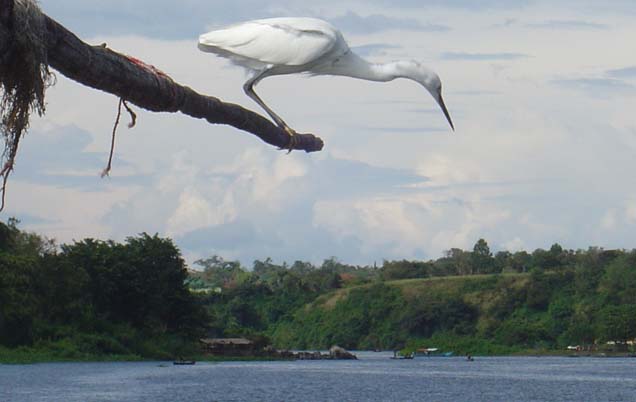
| Greetings Home |
| Previous Greeting |
|
|
Crtd 06-05-29 Lastedit 20-11-24
Nile Source Life
You Are Not Alone!

Photo Our Home mooring. Cam pos. Type in GoogleEarth 0.4104564 N 33.1918229 E, Northward from Napoleon Bay towards the Source of the Nile. Bird: Aigret. �Video: Aigret ballet rope dancing on the under water part of one of our anchor lines.

Source of the Nile, same view as above, but misty morning

Photo: Our Local Otter Family Heading Home After Its Daily Sunrise Looting Of Harbour Village Refuse Dump. The rest of the day they eat fish. When they decide to eat shell fish they swim on their backs, put it on their bellies and crack it by beating with a stone they brought from the land. They have real hands, like squirrels, primates and humans, that is, with independent control over the thumb. They are smarter than humans, of course, no need to say, but even match dogs and rats in intelligence.

Photo: More Fish Otters
The Fish Eagle (1 m high 2 m wing span) picks the fish with its claws. If it falls in the water there is no easy way out. Kites (60% of the fish eagle's size) fish similarly but also scavenge on land, like Marabu (up to 1.5 m high, wing span up to 2.5 m), who do not seek the open water surface but stand on their long legs at the shore side waiting for fish to pass there. Marabu next to fish factory premises in Kassansero

Pelicans (bigger than Marabu!), solitary fishers. They swim and charge in a fast neck movement with their mighty sword-beaks. Young ones (right) stay together and are not shy to get near people
The king fishers (15 cm) can not swim but dive and pick tiny
dagaa (silverfish) which they silence by banging them on our gaff [�video:
kingfisher got one! 080922]
Photo: this 8 cm bird sitting on our folmali is equipped with a 4 cm long orange fisher's beak. Photo right: off a post card. The tiny dagaa (silverfish) are probably assumed to think: "Oh orange, no king fishers here". On the post card he (she?) is called a "Malachite" Kingfisher all right...

Photo: It Took Him A Few Weeks To Copy The King Fishers. But now this cormorant can fish from our continuously moving anchor line without falling.
Jinja day fishers usually throw round nets
Dagaa

Photo: (Human) Night Fishers put nets with lights to attract dagaa (a match-size fish), this light line is more than 8 km long , hence stretches over the horizon. It roughly leads along the red line marking 8 km on the Jinja Bay Map

Photo: dagaa fishers going home at sunrise
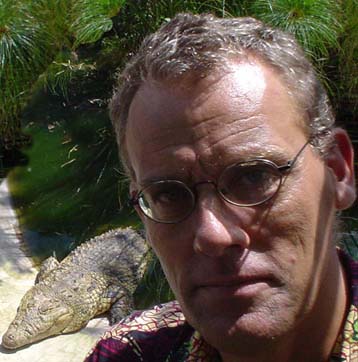
Photo: Fishers often report having seen a crocodile but we saw them only near Buvuma Island, 8 km East of our mooring.
For month or so, we did have a hippo around
the boat. It left, probably people too often chased it because its nightly
grazing sites naturally often were shamba's (gardens). We did see hippo's around
the dhow at Banda, a Sese Island (photo).
Finally: the fish cause quite some havoc and carnage among each other down
there in the water.
Yet, so many fish survive and breed that tomorrow we'll have more than we can
swallow!
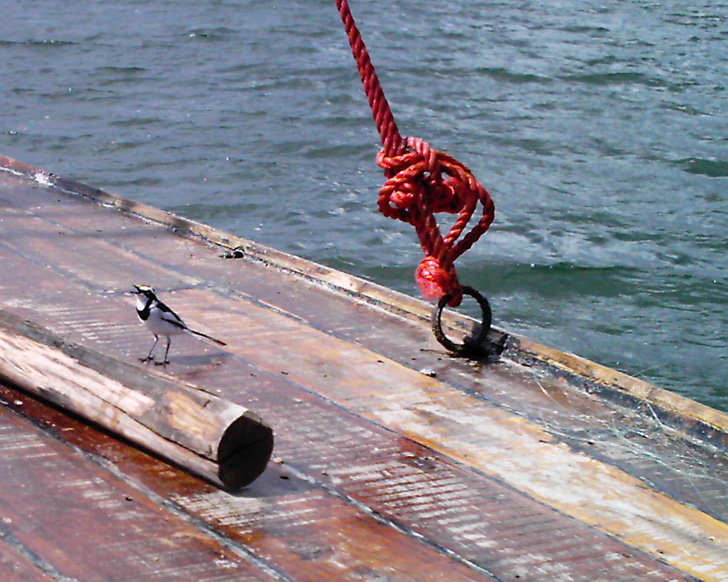
Photo: pied wagtail, never shy to be close (add the bird's sound)
We get daily visits, the first three hours after sunset, by zillions of lake flies of many sizes, nicely held outdoors by the net wire on our hatches. They come to mate and die
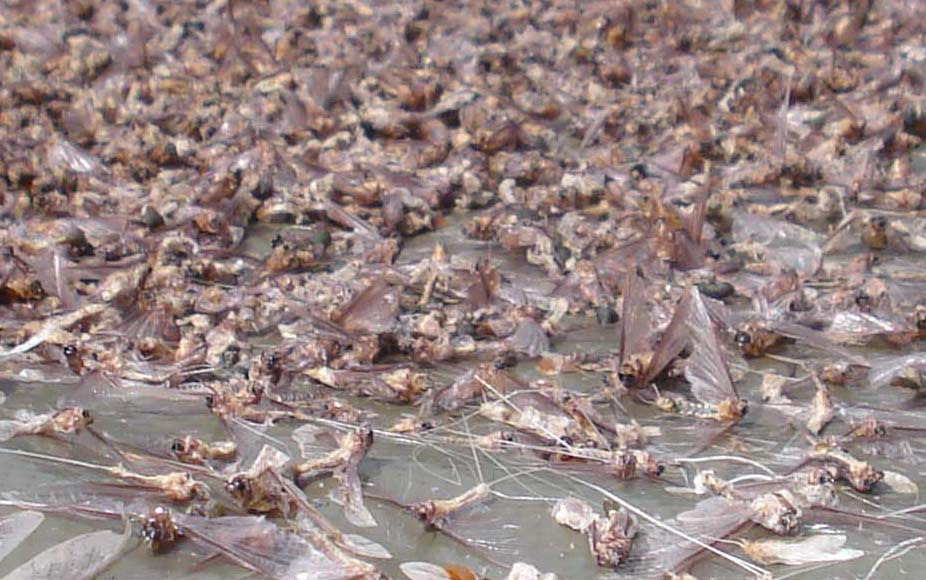
Photo: our morning harvest of lake flies on the deck
In the morning, a lot of dead bugs sit outside on the hulls of dhow and canoe. But if you look closely, they turn out to be only empty skins. It took us a while but finally we found that this is the larva where the dragonflies come out:
The dragonfly larva (left: changing into fly) turns out (right), my indispensable computer version of Encyclopedia Britannica informs, to be a fearsome predator of dagaa, may be to us a tiny fish but not to the larva: Indeed, relative to the dagaa, the dragonfly larva we see here in the lake are thicker but only a third of the length. Note the dagaa does not look amused.
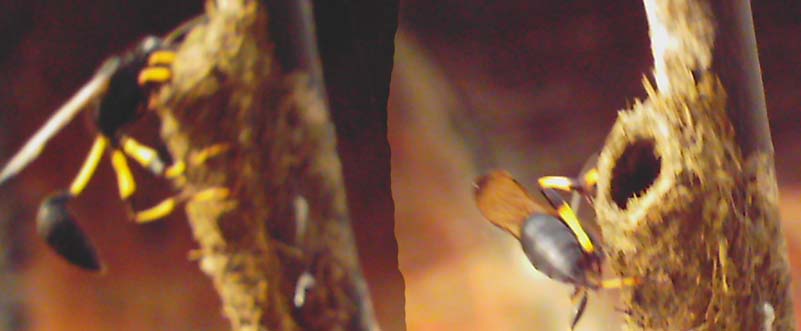
Photo: We have been warned for the bite of this space-station shaped wasp but they are friendly. They like the dhow for making egg nests using a very hard clay they shuttle from the shore. They stuff the inside with dead spiders, and then lay an egg. Our antenna wire is a popular nesting structure. We leave them (hear the wasp)
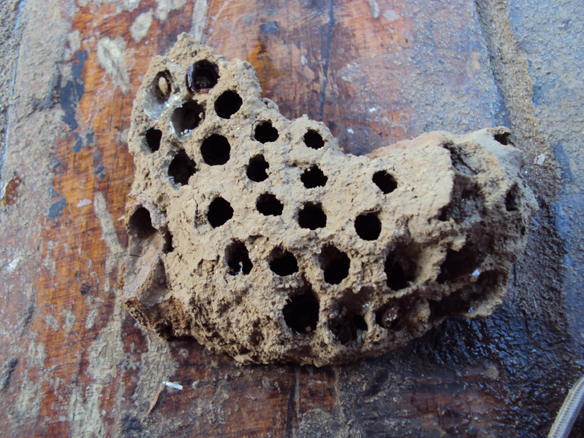
I 'm always amazed some keep thinking of tool using as
special for humans of primates, and about animal tool making.
This baby survival enhancing tool (BSET) is forged by a wasp mama (same type as
on as previous photo).
After shaping mud, flown in from hundreds of meters, she puts some dead spiders in each hole by way of
starter- food kit, then lays an egg in each hole. I do not think such things as
flying to the moon are on the other side of some dichotomy.
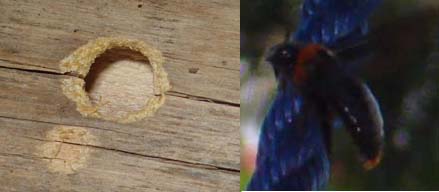
Photo: this one bores a wood-nest, the size of a big man's thumbnail. It carefully looks for rotten places in our wood, after all, why make life too difficult? Her husband(?) is smaller and yellow.
See (and hear also): the
Pied Wagtail, of couple
of whom considers itself the owner of the dhow, singing with astonishing
loudness from sunrise to sunset (also on: Greetings
from some characteristic birds (in Dutch)
For our fish see:
Furu,
Sato (Tilapia), Dagaa
Photo: Snake resting on our canoe mooring line after his long journey from
the shore to our boat.
Could he come up? Yes! Nice fellow to help us kill the XXL rats who preceded
him? May Be...
For a green snake on board click
here
For a cobra catch at the adjacent Jinja Club golf course click
here
Photo: (Dead) Rat (cut our electricity wire without dying though).
We are also popular among young monitor lizard (varanus) exploring the hollow parts of our boards for a sleeping nest. Adults of the lake variant can grow up to 2 m. When an adult passes you in the lake, as one did a few weeks ago, it looks bigger than a crocodile because it keeps its entire head above the water [adult monitor lizard at Ngamba Island, a 2+ m at Bunga Harbour Kampala].

Photo: Baby monitor lizards (varanus) like our floating island until they are to heavy to climb the boards adults can grow over 2 m.
Last but not least, an inflatable canoe with multicultural crew, in for a soda and a swim at our dhow,
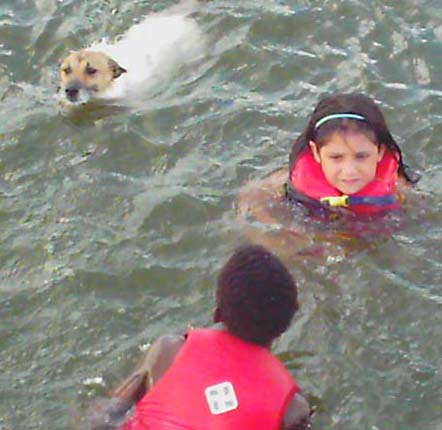
Photo: a swimming gang around our dhow
| Greetings Home |
| Previous Greeting |
|
|